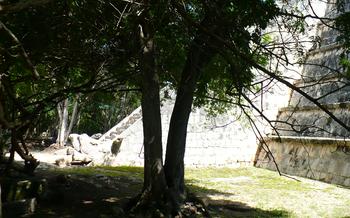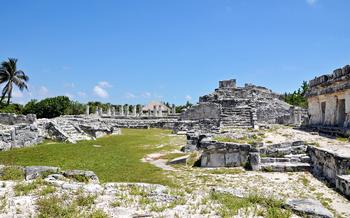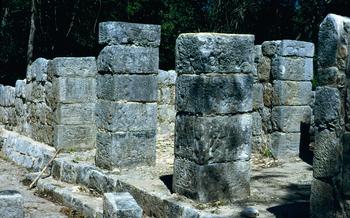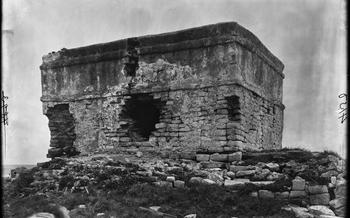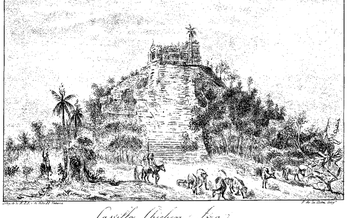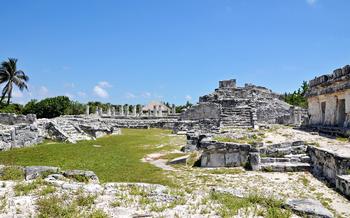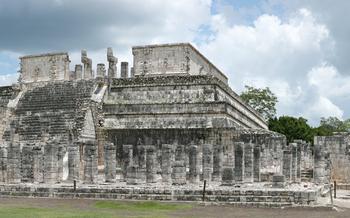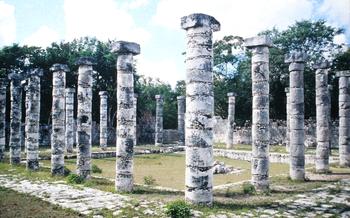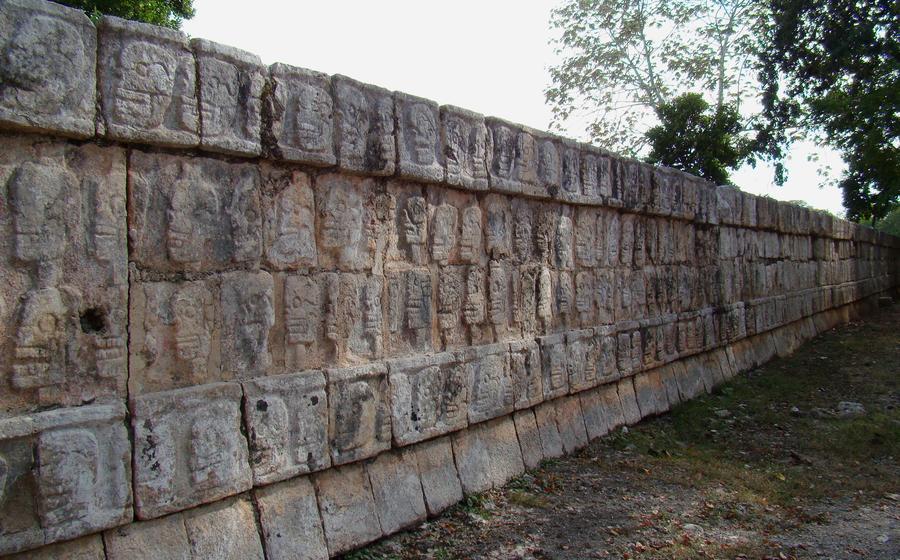
The Tzompantli (Skull Rack)
- A Glimpse into the Ancient Mayan Culture:
- Unveiling the History of Tzompantli
- Exploring the Architecture and Design
- The Skulls - A Symbol of Ritual Sacrifice
- Tzompantli and the Ballgame:
- The Cultural Significance of Skulls
- Preservation and Conservation Efforts
- Visiting the Tzompantli Today: Unveiling the Secrets of the Skull Rack
- Reflecting on the Past
- The Tzompantli and Modern Society
- Unraveling Mayan Symbolism
- The Legacy of the Tzompantli
- The Future of the Tzompantli
- Ethical Considerations
- Insider Tip:
A Glimpse into the Ancient Mayan Culture:
Chichen Itza, one of the most celebrated Mayan cities, offers a captivating glimpse into the advanced civilization that once flourished in Mesoamerica. Among its awe-inspiring structures, the Tzompantli stands as a chilling testament to the complex and often misunderstood Mayan culture. This skull rack, constructed from human skulls, unveils the deep significance of human sacrifice, power dynamics, and the veneration of death in Mayan society. The Tzompantli serves as a poignant reminder of the intricate beliefs and practices that shaped this ancient civilization.
Unveiling the History of Tzompantli
The Tzompantli, a chilling testament to the ancient Mayan civilization, stands as a grim reminder of their intricate rituals and beliefs. This macabre structure, constructed from thousands of human skulls, is a testament to the power, influence, and religious practices of Chichen Itza. Originally conceived as a platform for displaying the severed heads of sacrificial victims, the Tzompantli served as a potent symbol of warning and intimidation to enemies and a reminder of the city's dominance.
The skull rack's origins are shrouded in mystery, believed to date back to the Terminal Classic period (800-1000 AD). Constructed from limestone, the Tzompantli features a series of horizontal poles or beams supported by vertical posts, creating a gruesome display of human skulls. The placement of the skulls suggests a deliberate arrangement, with each skull carefully positioned to maximize its visibility and impact.
The Tzompantli's ritualistic significance is deeply intertwined with the Mayan belief system. Human sacrifice played a central role in Mayan culture, seen as a sacred act to appease the gods, ensure fertility, and maintain cosmic balance. The decapitation of sacrificial victims and the subsequent display of their skulls served as a powerful symbol of the Mayans' religious devotion and their belief in the afterlife.
The Tzompantli's existence reflects the power and influence wielded by Chichen Itza, one of the most prominent Mayan city-states. The city's dominance extended beyond its physical boundaries, with its cultural and religious influence permeating the region. The Tzompantli served as a stark reminder of Chichen Itza's authority and its ability to exert control over its subjects and rivals alike.
Exploring the Architecture and Design
The Tzompantli at Chichen Itza stands as a testament to the architectural prowess of the Mayans. Constructed from limestone blocks, this skull rack exhibits unique features that set it apart from other similar structures. Its rectangular shape, measuring approximately 65 feet in length and 9 feet in height, creates a striking visual impact.
The skull placement on the Tzompantli follows a specific pattern, with rows of skulls arranged in a grid-like formation. This arrangement not only adds to the aesthetic appeal of the structure but also symbolizes the order and precision that characterized Mayan society. The skulls are positioned in such a way that they face outward, creating a chilling effect as visitors encounter the rack.
The materials used in the construction of the Tzompantli further enhance its significance. Limestone, a durable and versatile material, was carefully chosen for its ability to withstand the elements and ensure the longevity of the structure. The use of limestone also allowed the Mayans to achieve intricate carvings and embellishments on the Tzompantli, showcasing their artistic prowess and attention to detail.
The Tzompantli's design reflects the Mayans' deep understanding of architecture and engineering. The precision of its construction, the careful placement of the skulls, and the use of durable materials demonstrate the advanced level of skill and knowledge possessed by the Mayan builders. This architectural marvel stands as a testament to their ingenuity and their ability to create structures that are both visually stunning and deeply symbolic.
The Skulls - A Symbol of Ritual Sacrifice
The skulls that adorned the Tzompantli were not merely decorative elements; they held profound significance in Mayan culture. They represented the severed heads of sacrificial victims, individuals who were ritually killed to appease the gods and ensure the continuation of life.
The Mayans believed that human sacrifice was the ultimate offering to their deities. By sacrificing a human life, they sought to establish a connection with the divine realm and secure divine favor. The decapitation of the victim symbolized the release of the soul from the body, allowing it to ascend to the heavens and intercede with the gods on behalf of the living.
The skulls themselves were not just discarded remains; they were treated with reverence and respect. They were carefully arranged on the Tzompantli, often in rows or columns, creating a macabre display of sacrificial offerings. The placement of the skulls was not random; it followed a specific order based on the status of the victim and the ritual's significance.
The skulls served as a stark reminder of the Mayans' belief in the afterlife and the importance of ritual sacrifice in their culture. They represented the power and influence of Chichen Itza, showcasing the city's dominance and its role as a major religious and ceremonial center.
Tzompantli and the Ballgame:
The Tzompantli is inextricably linked to the Mayan ballgame, a ritualistic and highly significant sport in Mayan culture. The game, often played with a rubber ball, held deep religious and political implications, and the outcome had profound consequences. In some variations of the game, the losing team's captain faced a grim fate – ritualistic decapitation.
The decapitated heads were then displayed prominently on the Tzompantli, serving as a chilling symbol of victory and a stark reminder of the high stakes involved in the game. The placement of the skulls on the rack was believed to honor the deceased and appease the gods, ensuring their continued favor and protection.
The ballgame was not merely a sport but a sacred ritual that mirrored the cosmic struggle between life and death. The placement of the skulls on the Tzompantli symbolized the triumph of life over death, further emphasizing the deep spiritual significance of the game in Mayan culture.
The Cultural Significance of Skulls
To the ancient Mayans, skulls held a profound significance beyond their physical form. They believed that the skull was a representation of the individual's spirit and essence, housing the soul after death. Skulls were revered as sacred objects, symbolizing both death and rebirth. They were often adorned with intricate carvings or painted with vibrant colors, reflecting the belief that death was not an end but a transition to another realm of existence.
Skulls were also intricately linked to Mayan rituals and ceremonies. They were used as offerings to the gods, placed in temples and altars as a way to honor and appease the deities. The placement of skulls in prominent locations was believed to bring good fortune, ward off evil spirits, and protect the community from harm. The veneration of skulls was a testament to the Mayans' deep reverence for the afterlife and their belief in the interconnectedness of life and death.
Preservation and Conservation Efforts
The preservation of the Tzompantli as a cultural heritage site is of utmost importance. This ancient artifact stands as a testament to the rich history and traditions of the Mayan civilization. However, time and natural elements pose significant challenges to its preservation. The restoration and conservation projects undertaken by various organizations aim to maintain the structural integrity of the Tzompantli and prevent further deterioration. These efforts involve careful cleaning and maintenance of the stone platform, as well as the use of specialized techniques to stabilize the skulls and prevent their decay. The involvement of international organizations in these projects brings expertise and resources to ensure the preservation of this significant cultural heritage for future generations.
Visiting the Tzompantli Today: Unveiling the Secrets of the Skull Rack
The Tzompantli, a captivating relic of Mayan civilization, stands within the sprawling complex of Chichen Itza, beckoning visitors to delve into its enigmatic history. Reaching the skull rack is a journey in itself, as you traverse the ancient pathways, surrounded by towering structures that evoke a sense of awe and wonder. The best time to visit the Tzompantli is during the early morning or late afternoon, when the sun's golden rays cast an ethereal glow upon the site, creating an unforgettable ambiance.
To fully comprehend the significance of the Tzompantli, consider joining a guided tour led by knowledgeable experts. These guides bring the skull rack to life, narrating tales of ancient rituals, human sacrifice, and the profound symbolism embedded within each skull. They provide insights into Mayan culture, shedding light on the beliefs and practices that shaped this extraordinary civilization.
As you stand before the Tzompantli, take a moment to capture its haunting beauty through photography. The play of light and shadow creates dramatic compositions, allowing you to immortalize the skull rack's majesty. Remember to be respectful when taking photographs, ensuring that your actions do not disrupt the tranquility of the site.
Visiting the Tzompantli is an experience that transcends time, transporting you back to an era of ancient rituals and profound beliefs. It is a journey that unveils the secrets of the Mayan civilization, leaving an indelible mark on the soul of every traveler who ventures into its presence.
Reflecting on the Past
Visiting the Tzompantli inevitably evokes a range of emotions, stirring contemplation on the cultural and historical significance of this ancient relic. The skull rack stands as a testament to the complex belief systems and practices of the Mayan civilization. It prompts us to reflect on the motivations and rituals that led to the creation of such a macabre display. Understanding the context and symbolism of the Tzompantli allows us to gain insights into the worldview and values of the ancient Mayans. It reminds us of the importance of understanding and appreciating the diversity of human cultures, even those that may seem foreign or disturbing to our modern sensibilities. The Tzompantli serves as a powerful reminder of the impermanence of life and the enduring legacy of ancient civilizations. It invites us to ponder the lessons we can learn from the past, encouraging us to question our own beliefs and assumptions about life, death, and the afterlife.
The Tzompantli and Modern Society
The Tzompantli has left an enduring mark on contemporary art, literature, and pop culture. Its distinct imagery has been used as a symbol in various media, evoking a sense of mystery, intrigue, and awe. The skull rack has been featured in films, television shows, video games, and even music videos, captivating audiences with its unique and powerful presence.
Beyond its aesthetic influence, the Tzompantli has sparked ongoing debates surrounding the ethical implications of displaying human remains. Museums and cultural institutions face the challenge of presenting these artifacts responsibly, ensuring that they are treated with the utmost respect and sensitivity. There is a delicate balance between preserving cultural heritage and respecting the dignity of the individuals whose remains are on display.
Ethical guidelines have been developed to guide the handling and display of human remains in museums and cultural institutions. These guidelines emphasize the importance of obtaining informed consent, ensuring proper documentation, and providing appropriate contextual information to visitors. By adhering to these ethical principles, museums can contribute to a deeper understanding of ancient cultures while respecting the legacy of those who came before us.
Unraveling Mayan Symbolism
The Tzompantli holds profound symbolic significance within Mayan culture, extending beyond its role as a skull rack. It embodies the complex interplay of power, death, and sacrifice, deeply embedded in Mayan beliefs. The arrangement of skulls on the rack represented a hierarchy of power, with the most prominent skulls belonging to high-ranking individuals or those who had demonstrated exceptional bravery in battle.
The placement of the skulls also aligned with Mayan cosmology, reflecting their belief in the underworld. The skulls faced west, symbolizing the setting sun and the journey into the afterlife. They were believed to serve as offerings to the Mayan gods, appeasing them and ensuring the continued favor of the divine.
Furthermore, the Tzompantli represented the cyclical nature of life and death. The skulls, once part of living beings, were transformed into symbols of death and sacrifice, yet they also held the potential for rebirth. They embodied the belief that death was not the end but a transition to a new existence in the afterlife.
The Legacy of the Tzompantli
The Tzompantli left a lasting impression on Mayan culture and beyond, serving as a potent symbol of power, death, and sacrifice. Its influence extended to subsequent civilizations, influencing their practices and beliefs. Understanding the legacy of the Tzompantli is crucial for comprehending the broader context of Mayan history.
The skull rack played a significant role in shaping our understanding of Mayan civilization. Through archaeological excavations and studies, the Tzompantli has provided valuable insights into the intricate rituals, beliefs, and social structures of the Maya. It has helped scholars reconstruct the historical narrative of Chichen Itza and shed light on the complex relationship between religion, politics, and society in ancient Mesoamerica.
The Tzompantli's legacy extends beyond the boundaries of Mayan culture. It has captivated the imaginations of artists, writers, and filmmakers, inspiring various works of art, literature, and popular culture. The skull rack's enduring fascination stems from its symbolic power and its ability to evoke emotions ranging from awe and curiosity to contemplation and unease.
Preserving and understanding the legacy of the Tzompantli is essential for appreciating the richness and diversity of human history. It reminds us of the intricate belief systems and cultural practices of past civilizations, encouraging us to reflect on our own mortality and the enduring impact of our actions.
The Future of the Tzompantli
The Tzompantli, a testament to the rich history and cultural practices of the Mayans, faces significant challenges in its preservation for future generations. The ravages of time, coupled with environmental factors and the impact of tourism, pose a constant threat to its structural integrity. Ongoing conservation efforts, spearheaded by archaeologists, historians, and cultural institutions, play a crucial role in mitigating these challenges. These efforts include regular monitoring, maintenance, and restoration work, ensuring the longevity of this iconic monument.
Moreover, the advent of modern technology offers innovative solutions for preserving the Tzompantli. Three-dimensional scanning and modeling techniques provide detailed digital replicas, allowing researchers to study and document the skull rack without compromising its physical integrity. These digital archives serve as a valuable resource for future generations, enabling them to explore and learn from this ancient artifact in virtual spaces.
Continuous research and exploration around the Tzompantli hold the potential for further discoveries and insights into Mayan culture. Archaeological excavations in the vicinity of the skull rack may uncover additional artifacts or provide new perspectives on its construction, use, and significance. Ongoing studies on the cultural and historical context of the Tzompantli contribute to a deeper understanding of Mayan society, shedding light on their beliefs, rituals, and practices.
Ethical Considerations
The display of human remains, particularly in a cultural context, raises ethical considerations that require careful navigation. The Tzompantli, with its collection of human skulls, presents a unique challenge in this regard. Museums and cultural institutions must strike a balance between preserving and showcasing the historical significance of the skull rack while respecting the cultural sensitivities and beliefs associated with it.
To address these ethical concerns, museums should engage in transparent and respectful dialogue with indigenous communities and experts to ensure that the display of the Tzompantli is done in a manner that is both informative and culturally sensitive. It is crucial to contextualize the skull rack within its historical and cultural framework, providing visitors with a comprehensive understanding of its significance and the practices that led to its creation.
Additionally, museums should consider implementing ethical guidelines for the display of human remains. These guidelines should address issues such as consent, repatriation, and the respectful handling and storage of the remains. By adhering to these guidelines, museums can demonstrate their commitment to preserving cultural heritage while upholding ethical standards.
By fostering open dialogue, providing comprehensive information, and adhering to ethical guidelines, museums can ensure that the display of the Tzompantli serves as a valuable educational tool that promotes understanding and respect for the cultural legacy of the ancient Mayans.
Insider Tip:
As you stand before the Tzompantli, let the weight of its history wash over you. This chilling monument is a testament to the complex and fascinating culture of the ancient Mayans. Take a moment to contemplate the lives of those whose skulls once adorned this rack, the rituals and beliefs that shaped their society, and the enduring legacy they have left behind. Remember, the Tzompantli is not just a collection of skulls; it is a window into a world that is both distant and yet eerily close.
